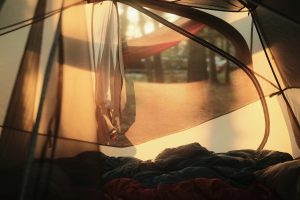Our top tips for getting your tots to sleep in the great outdoors!
Camping with your young children can be a magical experience for your entire family. From star gazing, to roasting marshmallows, camping is a childhood memory that’ll be forever treasured. However, when it comes to bedtime, your adventure can suddenly turn unpredictable and stressful. Nobody wants to handle temper tantrums from overtired toddlers, especially on holiday!
So, whether it’s combating cold nights, accommodating mid-day naps, or just adjusting to a new environment, here’s our top advice on how to make the nights as enjoyable as the days.
Create a cosy environment
If you want your child to fall asleep quickly so they wake up energised, you need to take the steps to recreate their home environment. Routine is everything when it comes to bedtime, and if it collapses while camping, you might struggle more than you’d expect. Whether it’s their favourite cuddly toy or a familiar blanket, home comforts do wonders for soothing your child to sleep. Although, we’d also recommend limiting marshmallows right before bed!
Maintain a consistent temperature
One way of recreating their bedroom at home is by maintaining a comfortable temperature. It’s easy for the cold to creep up through the ground when sleeping in a tent, which is why buying the right sleeping bag (and insulated mattress) is crucial. Consider having your smaller children cuddled in with you – that way they’re less likely to stir in the middle of the night and will probably fall asleep quicker. Although babies can’t sleep in adult sleeping bags due to the suffocation risk, specific versions exist and are a great tool for infant sleep.
Baby sleeping bags maintain a consistent temperature whilst allowing stretch and wiggle room for max comfort and safety. They also become a recognisable and central part of your baby’s night-time routine, which makes them even more useful for nights away from home.

Temperature regulations for infants
Experts recommend that 16-20 ֯C is the optimal room temperature for baby sleep. When camping, it’s a fine balance between keeping your baby warm whilst still watching for any signs of overheating. The risk of SIDS greatly increases if your baby overheats, so always remain aware and informed.
What tog sleeping bag for baby is right?
The higher the tog, the thicker the sleeping bag’s lining and material!
The right tog sleeping bag depends on when and where you’re planning on going on your adventure. It’s probably best to leave camping as a summer activity, at least while your children are very young.
A 2.5 tog is great for year-round use and for room temperatures of about 16-20 ֯C. However, for camping in the great outdoors, a sleeping bag tog 3.5 is more suitable for cooler environments and temperatures below 16 ֯C.
What should children wear to bed when camping?
But to keep your baby as snug as a bug, a sleeping bag may not be enough. That’s why base layers made of breathable fabrics are vital. If your child is of toddler age, socks and even a thin hat may be useful for preventing heat loss via their extremities. Additionally, a digital thermometer is an excellent piece of kit to take along on your trip to monitor body temperatures.
How to wash a sleeping bag
Knowing how to wash a sleeping bag is an underrated but essential step for a cosy experience every time you camp. Just like your at-home bedding, sleeping bags need to be washed depending on how often you use them. This protects their condition, loft/volume and consequently your family’s quality of sleep. You should check if your sleeping bag is machine-washable but if not, you can always hand-wash with warm, soapy water. Make sure to dry it, unzipped, on a washing line for at least 24 hours.
Maintaining a sleep routine
While these top tips should have your child sleeping soundly (with plenty of energy for the next adventure-filled day), sometimes children crash out no matter what!
Maintain your child’s regular sleep routine, even while camping, and you’ll find it’s much more fun for everyone involved. You could position your tent or car somewhere shaded and settle them down for a mid-day siesta. If they’re usually settled for a nap with a song or book, try to implement these too. An adult should remain in the tent at all times whilst your baby sleeps. You should also maintain proper ventilation within the tent as even a small bit of sun can quickly heat the internal temperature of the tent in seconds.
Otherwise, if you find yourself exploring the local area, and uh-oh, its nap time… try and settle them down as soon as you can, whether that’s overlooking a natural scene or finding the nearest pub. If the weather is chilly, you’ll want to bring some essentials for their snooze. Roll out their little sleeping bag and soothe them into a power nap, plus you get to keep your lap and arms toddler-free!
How to attach a sleeping bag to a backpack
If you have no idea how to attach a sleeping bag to your backpack, know that it’s easy. Simply assess the compatibility of your backpack and where the points of attachment are (such as built-in loops or an external frame). Then, thread your backpack straps through the rolled-up sleeping bag’s loops. You’ll need to buckle the straps securely, to make sure it’ll stay put throughout your journey.
Invest in a baby carrier
Otherwise, if your child is small, a baby carrier is likely to be an invaluable investment. You can enjoy a gentle hike with your tiny one strapped to your chest – the steady movement and snuggles are sure to rock your baby to sleep.
You should always expect the unexpected when it comes to young children. But just remember that it’s not about perfection but rather making precious memories. With fresh air, the right gear, and a bit of forward planning using our top tips, you’ll come away with life-long stories (and hopefully a good couple hours of sleep too).
Always do your research into the exact products you’ll need to ensure they’re right for your situation and needs, and always stay alert to changing outdoor weather conditions and its impact on your child.
For all of your camping needs, explore halfords.com today.



